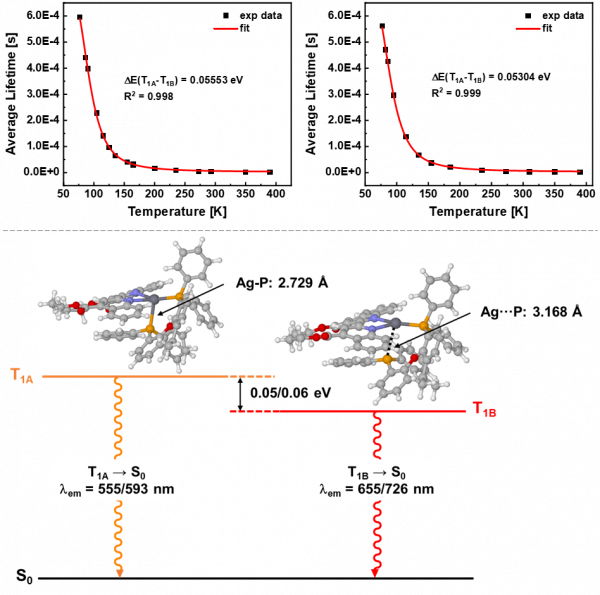We have designed the [Ag(xantphos)(deebq)]PF6 complex combining a large-bite angle diphosphine ligand (xantphos) and a rigid, sterically hindered, π-extended biquinolin (deebq). With this complex, we have developed the first red light-emitting electrochemical cells featuring improved stability of two orders of magnitude compared to prior-art.

Figure: Schematic representation of the equilibrium structures of the triplet excited states of [Ag(Xantphos)(deebq)] involved in the emission process, the experimentally obtained/calculated values of the emission wavelengths and the energy gap highlighting the thermal equilibration situation responsible for the dual phosphorescence observed in this system.
The design of red-emitting silver (I) complexes and their implementation in thin-film lighting are still challenging as i) their high ligand-field splitting energy leads to high-energy emissions with a controversial mechanism (thermally activated delayed fluorescence vs. fluorescence/phosphorescence), and ii) their low electrochemical stability leads to the formation of silver nanoclusters, limiting the device stability to a few seconds. Herein, we report a thoughtful complex design [Ag(Xantphos)(deebq)]PF
6 combining a large-bite angle diphosphine ligand (Xanthphos) and a rigid, sterically hindered, and π-extended biquinolin (deebq). In sharp contrast to prior-art, this complex possesses i) efficient red-emission (l
em=660 nm; photoluminescence quantum yield of 42%) assigned to a thermally equilibrated dual-phosphorescent emission based on spectroscopic/theoretical studies and ii) stable reduction behavior without forming silver nanoclusters. This results in the first red light-emitting electrochemical cells featuring i) an improved stability of two orders of magnitude compared to the prior-art (from seconds to hours) at irradiances of 20 mW/cm
2, and ii) a new degradation mechanism exclusively related to p-doping as confirmed by electrochemical impedance spectroscopy analysis. Indeed, a multilayered architecture to decouple hole injection/transport and exciton formation enabled a further 2-fold enhanced irradiance/stability. Overall, this work illustrates that deciphering the rules for silver(I) complex design for lighting is tricky, but worthy.




